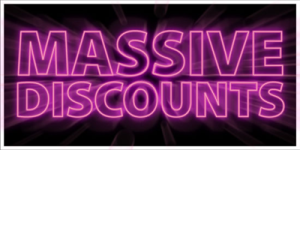Literally. I have gone fishing and will resume my posts next week.
Thanks for following my blog.
Literally. I have gone fishing and will resume my posts next week.
Thanks for following my blog.
Filed under Uncategorized
 Discounted prices have become synonymous with this economic downturn and the damage it is doing to business can be seen in the bottom line.
Discounted prices have become synonymous with this economic downturn and the damage it is doing to business can be seen in the bottom line.
Worse, business is now telling consumers that “if you wait long enough, we’ll continue to lower our prices” giving the consumer little incentive to purchase early and pay full price. Not to mention the impact discounting has on your brand.
Instead of discounting, innovate.
Quizno’s created new products – the $4 Torpedo and $3 Bullet – that they could sell for less money yet maintain profitable margins. Second week sales of the Torpedo increased 26%.
In contrast, Yum Brands (Taco Bell & Pizza Hut) reported a 1% decline in second quarter same store earnings, due in part to offering deals on their existing menu items with shrinking margins.
On a different scale, companies like Dell and HP have introduced NetBooks, wireless devices geared for email and social networking without many of the features of more expensive desktop or laptop computers. These too were developed with both price point and margin in mind.
Before this week is over, think about what you can do in your business to meet the budgetary needs of your audience while maintaining the margins you need to be successful. This winning combination can help restore faith in your brand – and your bottom line.
Filed under recession marketing
 First came Blockbuster movie rentals and its counterparts.
First came Blockbuster movie rentals and its counterparts.
Then, as videos gave way to DVDs, Netflix reinvented movie rental with its monthly subscription service. Its pitch was simple: DVDs delivered right to your door with no late fees.
Now, Netflix and others are evolving that model and delivering movies right to your computer or TV.
So how can a company succeed by making people drive to pick up their DVDs again?
RedBox has found a way, by finding Blue Ocean – a new way of thinking – among the crowded Red Ocean movie rental industry.
In this case, RedBox knew there was an opportunity in DVD rentals outside of what the biggest players were doing today. The key was finding a competitive position that would meet an unmet need.
So RedBox started using Blue Ocean thinking for DVD rentals, just like Netflix did a few years ago.
RedBox is a series of self-serve kiosks located at very convenient locations like grocery stores, drug stores, etc. You can grab a movie after you do your regular shopping. A RedBox rental costs $1 – with no late fees – and you can return your DVD at any RedBox location.
RedBox took this Blue Ocean approach and changed the game based on some key consumer insights.
As an added bonus, RedBox lets you reserve your favorite movies at the most convenient location through their website.
RedBox results: 147% growth last year; 105% growth the year prior.
Now is a great time to think about your business and determine what you can do differently from your competition. Costs to implement any changes are lower than they’ve been in years and the manpower and mindpower is available.
What Blue Ocean thinking can you apply to recreate your industry?
Filed under Competition, Innovation
 Is your company selling or are your consumers buying?
Is your company selling or are your consumers buying?
In marketing, it really doesn’t matter what you are selling; what matters is how your audience is buying.
The late Billy Mays and his business partner Anthony Sullivan knew this well.
At first glance you’d think their products were all about selling things people really didn’t need. If you ever watched Pitchmen, you’d see it wasn’t as much about what they were selling, but what the audience was buying.
People bought OxiClean for a better way to whiten their clothes or Shuffles for an easier way to clean their floors.
Mays and Sullivan didn’t take the product inventor’s word for it either – they went out and conducted their own research to learn the consumer benefits of each product. Only after understanding why the consumer was buying would they put their name behind it.
When I was working with a national pest control company, we were selling their effectiveness in killing bugs. After some ethnographic research, however, we discovered that consumers were really buying the pride that came with a clean home. Bugs weren’t seen as a nuisance or being gross; they were a reflection of that person’s ability to provide a clean environment for their family.
Changing our marketing approach to speak to what people were buying increased sales and customer retention.
Are you selling or are your consumers buying? Answer these five questions to find out:
If you answered “no” or “I don’t know” to any of these questions, take a step back and look at your entire organization: from how you answer the phone, handle a sales call, promote your company to communicate on your website.
Chances are you’re telling your customers what you want them to hear instead of answering what they need to hear. Remember – the audience is always buying if you deliver what they really and truly want.
Filed under Marketing Tactics